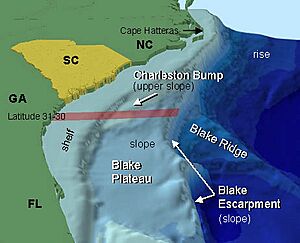Blake Plateau facts for kids

The Blake Plateau is a large, flat area under the western Atlantic Ocean. It's located off the coasts of North Carolina, South Carolina, Georgia, and Florida in the southeastern United States.
This underwater plateau is about 145 kilometers (90 miles) wide from east to west. It stretches about 170 kilometers (105 miles) from north to south. The water depth here ranges from about 500 meters (1,640 feet) closer to shore. It slopes down to about 1,000 meters (3,280 feet) further out.
At its eastern edge, the Blake Escarpment' is a steep drop-off. It plunges down to the very deep ocean basin. The Blake Plateau, along with the nearby Blake Ridge and Blake Basin, is named after a ship. This ship was the United States Coast and Geodetic Survey steamer Template:USC&GS. It was used from 1874 to 1905. This ship was important because it was the first to use strong steel cables for oceanographic work. It also helped explore the deep ocean and the Gulf Stream. The George S. Blakes early hydrographic surveys helped scientists first map this plateau.
The Blake Plateau is home to the world's largest known deep-water coral reef. This amazing reef covers 6.4 million acres. It stretches all the way from Miami, Florida, to Charleston, South Carolina.
Contents
Discovering the Blake Plateau
In July 1880, the ship George S. Blake was exploring the ocean. It was led by Commander John R. Bartlett. The crew was using special equipment to measure ocean depths. They were also collecting biological samples.
While measuring depths, they found something unexpected. The water was much shallower than they thought. This was especially true when they crossed the Gulf Stream. They found a "hard coral" bottom with little sea life. This was one of the first clues about the plateau.
In 1882, Commander Bartlett described this new underwater area. He said that instead of a deep channel, there was a wide, mostly flat plateau. It stretched from the Little Bahama Banks to Cape Hatteras. Off Cape Canaveral, it was nearly 370 kilometers (230 miles) wide. It got narrower as it went north.
Bartlett also noticed that the strong ocean currents affected the plateau. In areas with strong currents, the seafloor was "washed nearly bare." This meant the current was so strong it swept away loose material. Only small, broken pieces of coral rock were left.
Features of the Blake Plateau
Geology of the Plateau
The Blake Plateau has some unusual features. Strong currents like the Florida Current and the Antilles Current flow over it. These currents combine to form the powerful Gulf Stream. Because of these currents, scientists have long been interested in the minerals found here. These include manganese nodules. Also, methane and other gas hydrates are found on the plateau. Gas hydrates are like ice but contain gas trapped inside.
Amazing Ocean Life
For a long time, people thought the Blake Plateau was a "bleak, current-swept plain." But scientists knew it had some life, like Lophelia pertusa reefs. These reefs support many different sea creatures. Other communities of life are supported by the gas hydrates.
In 2024, an incredible discovery was announced. The Blake Plateau has the world's largest known deep-water coral reef! This massive reef covers 6.4 million acres. It stretches from Miami to Charleston, South Carolina.
This huge reef is made up of almost continuous coral mounds. These mounds can be up to 500 kilometers (310 miles) long and 110 kilometers (68 miles) wide. One part of the reef is even nicknamed "Million Mounds." It's the largest section of the reef. This part is made of stony coral. It's usually found at depths of 200 to 1,000 meters (656 to 3,280 feet). Scientists found this reef during sonar surveys that started in 2019.
Commercial fishermen have started catching deep sea fish on the plateau. Scientists are studying if this type of fishing is sustainable. This is because these deep-sea fish, even though they can be large, grow very slowly. It is hard to study the sea life on the deep bottom because of the strong Gulf Stream. This means we still don't know much about all the animals that live there.



